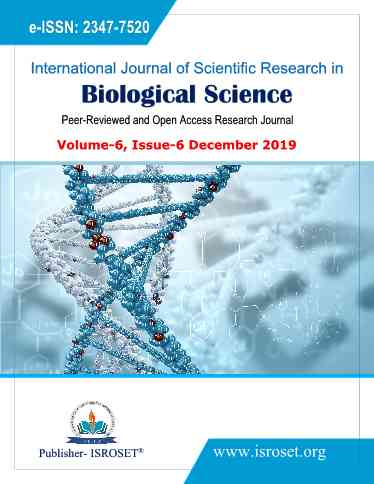Antioxidant, Cytotoxicity and Antitumor of Bergia suffruticosa (whole plant)
Keywords:
Bergia suffruticosa, Elatinaceae, Antioxidant, CytotoxicityAbstract
Bergia suffruticosa (Elatinaceae) is a plant that is collected from western Sudan. It is popularly used traditionally in the treatment as wounds healer and osteitis. This research aims to screen the cytotoxicity as well as antioxidants and the impact as antitumor of Bergia suffruticosa metabolites. Metabolites were extracted using different organic solvents to increasing polarity. The antioxidant was assessed using free radical scavenging activity DPPH. The petroleum ether extract was revealed the strongest antioxidant with IC50 89±0.01µg/ml, while the aqueous extract was revealed no antioxidant activity. The cytotoxicity was evaluated using the Brine shrimp lethality assay. Petroleum ether metabolites revealed high cytotoxicity with LD50 0.04ppm while the other metabolites were exhibited no cytotoxicity. The antitumor activity was assessed using SRB assay against tumor cell lines, breast carcinoma cell line (MCF7), Prostate carcinoma cell line (PC3), colon carcinoma cell line (HCT116). All metabolites were revealed activity against all cancer cells tested. The highest activity against breast cancer was exhibited by ethyl acetate with IC50 17 µg/ml. the petroleum ether extract was revealed the highest activity against prostate cancer cells with IC50 17.9 µg/ml.
References
S. Pattanayak, Alternative to Antibiotics from Herbal Origin - Outline of a Comprehensive Research Project, vol. 16, no. 1. 2018.
A. Barchan, M. Bakkali, A. Arakrak, R. Pagán, and A. Laglaoui, “The effects of solvents polarity on the phenolic contents and antioxidant activity of three Mentha species extracts,” Int. J. Curr. Microbiol. Appl. Sci., vol. 3, no. 11, pp. 399–412, 2014.
F. Angius and A. Floris, “Liposomes and MTT cell viability assay: An incompatible affair,” Toxicol. Vitr., vol. 29, no. 2, pp. 314–319, 2015.
T. O. Issa et al., “Ethnobotanical investigation on medicinal plants in Algoz area (South Kordofan), Sudan,” J. Ethnobiol. Ethnomed., vol. 14, no. 1, pp. 1–22, 2018.
M. A. Mohamed, “EFFECT OF PROCESSING ON AMINO ACIDS CONTENTS OF FOUR SPECIES OF THE,” vol. 6, no. 9, pp. 3775–3780, 2015.
P. Amudha, V. Vanitha, N. Pushpa Bharathi, M. Jayalakshmi, and S. Mohanasundaram, "Phytochemical analysis and invitro antioxidant screening of seagrass-Enhalus acoroides," Int. J. Res. Pharm. Sci., vol. 8, no. 2, pp. 251–258, 2017.
Y. Khan and S. Nasreen, “Screening for antioxidant potential in methanolic leaf extract of Madhuca Indica L .,” vol. 2, no. 9, pp. 849–851, 2016.
A. M. L. Genelyn G. Madjos1, "Comparative Cytotoxic Properties of Two Varieties of Carica papaya leaf extracts from Mindanao, the Philippines using Brine Shrimp Lethality Assay," Bull. Environ. Pharmacol. Life Sci., vol. 8, no. January, pp. 113–118, 2019.
J. Mangis, T. Mansur, K. Kern, and J. Schroeder, “Selection of an Optimal Cytotoxicity Assay for Undergraduate Research.,” Bioscience J. Coll. Biol. Teach., vol. 45, no. 1, pp. 24–32, 2019.
M. Vinken and V. Rogiers, "Protocols in in-vitro hepatocyte research," Protoc. Vitr. Hepatocyte Res., vol. 1250, pp. 1–390, 2015.
F. Q. Alali et al., “Phytochemical studies and cytotoxicity evaluations of Colchicum tunicatum Feinbr and Colchicum hierosolymitanum Feinbr (Colchicaceae): Two native Jordanian meadow saffrons,” Nat. Prod. Res., vol. 20, no. 6, pp. 558–566, 2006.
D. Jeyapragash, P. Subhashini, S. Raja, K. Abirami, and T. Thangaradjou, “Evaluation of In-vitro Antioxidant Activity of Seagrasses: Signals for Potential Alternate Source,” Free Radicals Antioxidants, vol. 6, no. 1, pp. 77–89, 2016.
K. C. Chinsembu, “Plants as antimalarial agents in Sub-Saharan Africa,” Acta Trop., vol. 152, pp. 32–48, 2015.
X. Xia et al., “Cellular antioxidant activity and cytotoxicity assay of canolol,” vol. 3, no. 2, pp. 111–121, 2018.
P. Senthilraja and K. Kathiresan, "In vitro cytotoxicity MTT assay in Vero, HepG2, and MCF-7 cell lines study of marine yeast," J. Appl. Pharm. Sci., vol. 5, no. 3, pp. 80–84, 2015.
K. Sak, T. H. Nguyen, V. D. Ho, T. T. Do, and A. Raal, “Cytotoxic effect of chamomile (Matricaria recutita) and marigold (Calendula officinalis) extracts on human melanoma SK-MEL-2 and epidermoid carcinoma KB cells,” Cogent Med., vol. 4, no. 1, pp. 1–7, 2017.
W. Cordier and V. Steenkamp, “Evaluation of Four Assays to Determine Cytotoxicity of Selected Crude Medicinal Plant Extracts In vitro,” Br. J. Pharm. Res., vol. 7, no. 1, pp. 16–21, 2015.
E. Of, P. Constituents, A. Property, D. N. A. Damage, I. Activity, and F. Waste, "Antioxidant Property, DNA Damage Inhibition Activity And Cytotoxicity Of Aster ( Callistephus Chinensis )," vol. 8, no. 5, pp. 977–991, 2019.
S. Handali et al., “A novel 5-Fluorouracil targeted delivery to colon cancer using folic acid conjugated liposomes,” Biomed. Pharmacother., vol. 108, no. July, pp. 1259–1273, 2018.
Downloads
Published
How to Cite
Issue
Section
License

This work is licensed under a Creative Commons Attribution 4.0 International License.
Authors contributing to this journal agree to publish their articles under the Creative Commons Attribution 4.0 International License, allowing third parties to share their work (copy, distribute, transmit) and to adapt it, under the condition that the authors are given credit and that in the event of reuse or distribution, the terms of this license are made clear.







